Launch configurations
To run or debug a simple app in VS Code, select Run and Debug on the Debug start view or press F5 and VS Code will try to run your currently active file.
However, for most debugging scenarios, creating a launch configuration file is beneficial because it allows you to configure and save debugging setup details. VS Code keeps debugging configuration information in a file located in a folder in your workspace (project root folder) or in your or .
To create a file, click the create a launch.json file link in the Run start view.
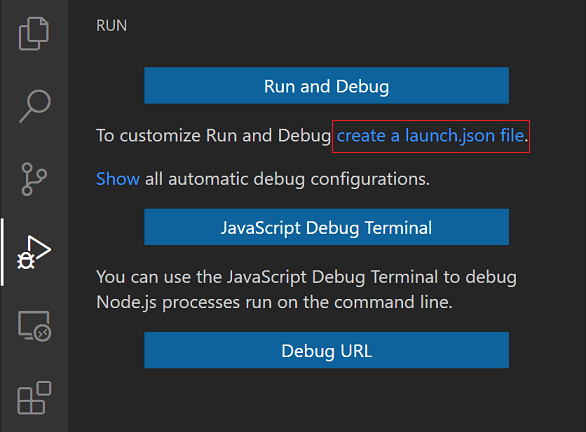
VS Code will try to automatically detect your debug environment, but if this fails, you will have to choose it manually:

Here is the launch configuration generated for Node.js debugging:
If you go back to the File Explorer view (⇧⌘E (Windows, Linux Ctrl+Shift+E)), you’ll see that VS Code has created a folder and added the file to your workspace.
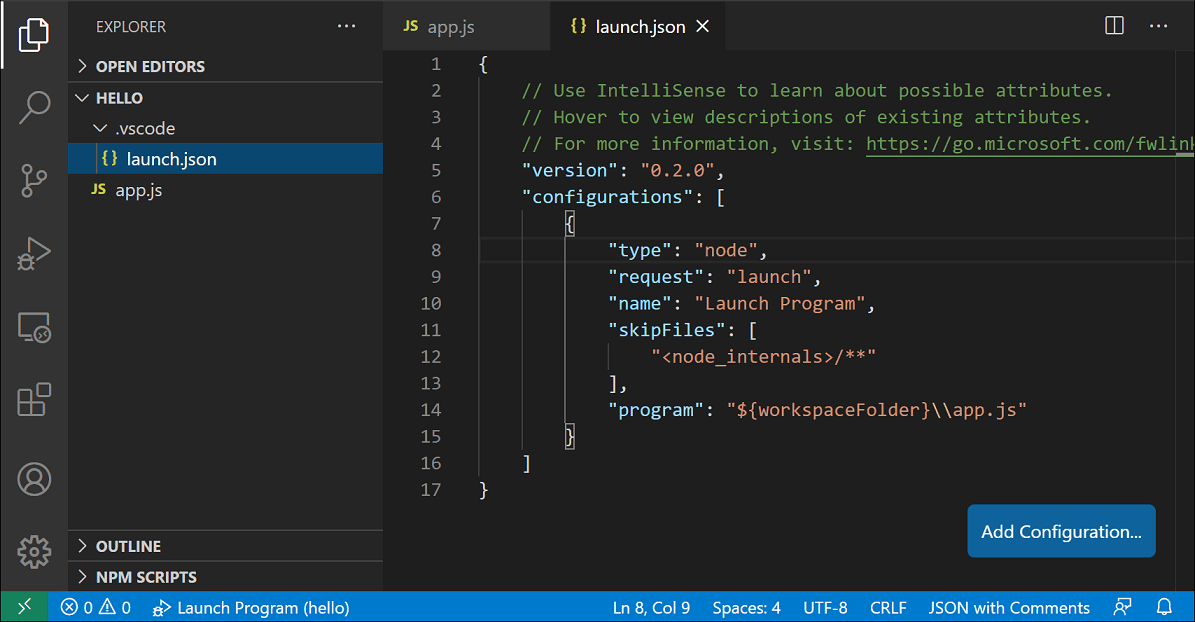
Note that the attributes available in launch configurations vary from debugger to debugger. You can use IntelliSense suggestions (⌃Space (Windows, Linux Ctrl+Space)) to find out which attributes exist for a specific debugger. Hover help is also available for all attributes.
Do not assume that an attribute that is available for one debugger automatically works for other debuggers too. If you see green squiggles in your launch configuration, hover over them to learn what the problem is and try to fix them before launching a debug session.
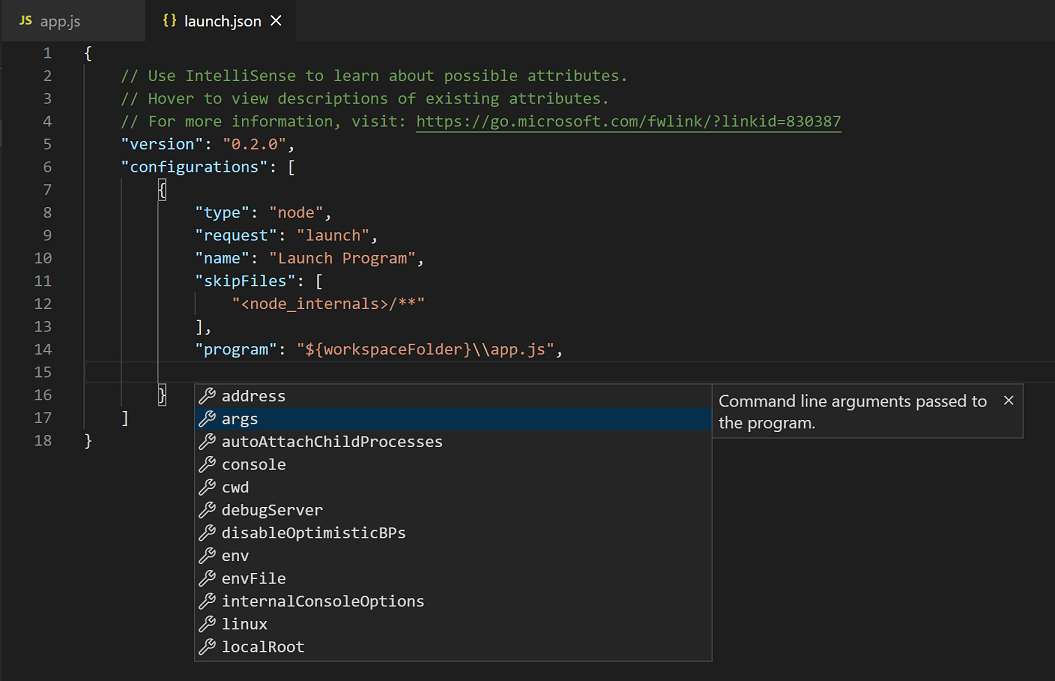
Review all automatically generated values and make sure that they make sense for your project and debugging environment.
Launch versus attach configurations
In VS Code, there are two core debugging modes, Launch and Attach, which handle two different workflows and segments of developers. Depending on your workflow, it can be confusing to know what type of configuration is appropriate for your project.
If you come from a browser Developer Tools background, you might not be used to «launching from your tool,» since your browser instance is already open. When you open DevTools, you are simply attaching DevTools to your open browser tab. On the other hand, if you come from a server or desktop background, it’s quite normal to have your editor launch your process for you, and your editor automatically attaches its debugger to the newly launched process.
The best way to explain the difference between launch and attach is to think of a launch configuration as a recipe for how to start your app in debug mode before VS Code attaches to it, while an attach configuration is a recipe for how to connect VS Code’s debugger to an app or process that’s already running.
VS Code debuggers typically support launching a program in debug mode or attaching to an already running program in debug mode. Depending on the request ( or ), different attributes are required, and VS Code’s validation and suggestions should help with that.
Add a new configuration
To add a new configuration to an existing , use one of the following techniques:
- Use IntelliSense if your cursor is located inside the configurations array.
- Press the Add Configuration button to invoke snippet IntelliSense at the start of the array.
- Choose Add Configuration option in the Run menu.
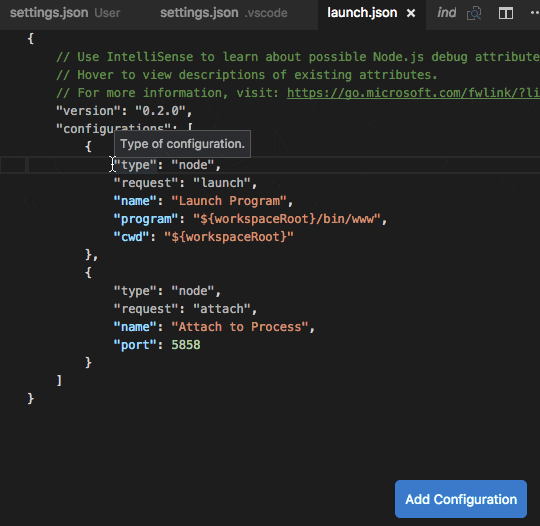
VS Code also supports compound launch configurations for starting multiple configurations at the same time; for more details, please read this .
In order to start a debug session, first select the configuration named Launch Program using the Configuration dropdown in the Run view. Once you have your launch configuration set, start your debug session with F5.
Alternatively, you can run your configuration through the Command Palette (⇧⌘P (Windows, Linux Ctrl+Shift+P)) by filtering on Debug: Select and Start Debugging or typing and selecting the configuration you want to debug.
As soon as a debugging session starts, the DEBUG CONSOLE panel is displayed and shows debugging output, and the Status Bar changes color (orange for default color themes):

In addition, the debug status appears in the Status Bar showing the active debug configuration. By selecting the debug status, a user can change the active launch configuration and start debugging without needing to open the Run view.
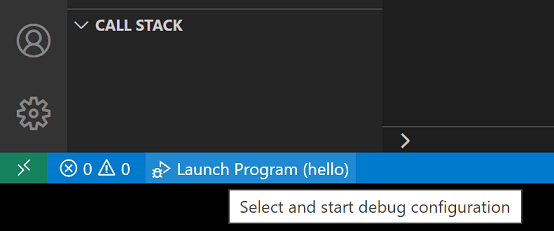
Resume Next
The Resume Next statement is used to clear the error and then resume the code from the line after where the error occurred.
If your code can have multiple errors and you want to keep detecting them then this line is very useful.
For example, in the following code we want to resume the code after the error has been reported:
Private Sub Main()
On Error Goto eh
Dim i As Long
For i = 1 To 3
' Generate type mismatch error
Error 13
Next i
done:
Exit Sub
eh:
Debug.Print i, Err.Description
End Sub
We could use to clear the code and then use a goto statement to go back to the code like this:
Private Sub Main()
On Error Goto eh
Dim i As Long
For i = 1 To 3
' Generate type mismatch error
Error 13
continue:
Next i
done:
Exit Sub
eh:
Debug.Print i, Err.Description
On Error Goto -1 ' clear the error
Goto continue ' return to the code
End Sub
The Resume Next provides a nicer way of doing it and it always means the code is much clearer and easier to understand:
Private Sub Main()
On Error Goto eh
Dim i As Long
For i = 1 To 3
' Generate type mismatch error
Error 13
continue:
Next i
done:
Exit Sub
eh:
Debug.Print i, Err.Description
' clear the error and return to the code
Resume Next
End Sub
Ошибки и обработка ошибок
При программировании приложения нужно учитывать, что происходит при возникновении ошибки. Ошибка в приложении может возникнуть по одной из двух причин. Во-первых, во время работы приложения могут возникать некоторые условия, приводящие к сбою кода, ранее работавшего исправно. Например, если код пытается открыть таблицу, удаленную пользователем, возникает ошибка. Во-вторых, код может содержать неправильную логику, препятствующую выполнению нужных действий. Например, ошибка возникает, если код пытается разделить значение на ноль.
Если вы реализовали обработку ошибок, Visual Basic приостанавливает выполнение и отображает сообщение об ошибке при возникновении ошибки в коде. Пользователи приложения, вероятнее всего, будут при этом озадачены и раздражены. Многие проблемы можно предотвратить, включив в свой код процессы тщательной обработки ошибок для обработки любых потенциальных ошибок.
При добавлении обработки ошибок в процедуру следует учитывать, как процедура направляет выполнение при возникновении ошибки. Первый этап направления в обработчик ошибок состоит во включении обработчика ошибок путем добавления одной из форм оператора On Error в процедуру. Оператор On Error направляет выполнение в событие ошибки. Если оператор On Error отсутствует, при возникновении ошибки Visual Basic просто приостанавливает выполнение и отображает сообщение об ошибке.
Если ошибка возникает в процедуре с включенным обработчиком ошибок, Visual Basic не отображает обычное сообщение об ошибке. Вместо этого он направляет выполнение в обработчик ошибок, при его наличии. Когда выполнение передается включенному обработчику ошибок, он становится активным. В активном обработчике ошибок можно определить тип возникшей ошибки и устранить ее выбранным способом. Приложение Access представляет три объекта, содержащих сведения о возникших ошибках: объект Error ADO, объект Err Visual Basic и объект Error DAO.
Exception handler lambda
An alternative to a is to provide a lambda to UseExceptionHandler. Using a lambda allows access to the error before returning the response.
Here’s an example of using a lambda for exception handling:
In the preceding code, is added so the Internet Explorer browser displays the error message rather than an IE error message. For more information, see this GitHub issue.
Warning
Do not serve sensitive error information from IExceptionHandlerFeature or IExceptionHandlerPathFeature to clients. Serving errors is a security risk.
To see the result of the exception handling lambda in the sample app, use the and preprocessor directives, and select Trigger an exception on the home page.
Summary of Predefined PL/SQL Exceptions
An internal exception is raised automatically if your PL/SQL program violates an Oracle rule or exceeds a system-dependent limit. PL/SQL predefines some common Oracle errors as exceptions. For example, PL/SQL raises the predefined exception if a statement returns no rows.
You can use the pragma to associate exception names with other Oracle error codes that you can anticipate. To handle unexpected Oracle errors, you can use the handler. Within this handler, you can call the functions and to return the Oracle error code and message text. Once you know the error code, you can use it with pragma and write a handler specifically for that error.
PL/SQL declares predefined exceptions globally in package . You need not declare them yourself. You can write handlers for predefined exceptions using the names in the following table:
Объект Promise
Начиная с ECMAScript2015, JavaScript поддерживает объект , который используется для отложенных и асинхронных операций.
Объект может находиться в следующих состояниях:
- ожидание (pending): начальное состояние, не выполнено и не отклонено.
- выполнено (fulfilled): операция завершена успешно.
- отклонено (rejected): операция завершена с ошибкой.
- заданный (settled): промис выполнен или отклонен, но не находится в состоянии ожидания.
Простой пример использования объектов и для загрузки изображения доступен в репозитории MDN promise-test на GitHub. Вы также можете посмотреть его в действии. Каждый шаг прокомментирован, что позволяет вам разобраться в архитектуре и XHR. Здесь приводится версия без комментариев:
- « Предыдущая статья
- Следующая статья »
How PL/SQL Exceptions Propagate
When an exception is raised, if PL/SQL cannot find a handler for it in the current block or subprogram, the exception propagates. That is, the exception reproduces itself in successive enclosing blocks until a handler is found or there are no more blocks to search. In the latter case, PL/SQL returns an unhandled exception error to the host environment.
However, exceptions cannot propagate across remote procedure calls (RPCs). Therefore, a PL/SQL block cannot catch an exception raised by a remote subprogram. For a workaround, see .
, , and illustrate the basic propagation rules.
Figure 7-3 Propagation Rules: Example 3
Text description of the illustration pls81011_propagation_rules_example3.gif
An exception can propagate beyond its scope, that is, beyond the block in which it was declared. Consider the following example:
BEGIN
...
DECLARE ---------- sub-block begins
past_due EXCEPTION;
BEGIN
...
IF ... THEN
RAISE past_due;
END IF;
END; ------------- sub-block ends
EXCEPTION
...
WHEN OTHERS THEN
ROLLBACK;
END;
Because the block in which exception was declared has no handler for it, the exception propagates to the enclosing block. But, according to the scope rules, enclosing blocks cannot reference exceptions declared in a sub-block. So, only an handler can catch the exception. If there is no handler for a user-defined exception, the calling application gets the following error:
ORA-06510: PL/SQL: unhandled user-defined exception
ЗАКЛЮЧИТЕЛЬНЫЙ ОТВЕТ
Если ваш провайдер не будет обновлять openSSL до TLS 1.2, вам следует серьезно подумать о другом провайдере. Вы должны проверить свой сервер с помощью ссылки «SSL SERVER TEST» ниже. Ваш сервер, вероятно, имеет уязвимости безопасности SSL.
Сервер, к которому вы пытаетесь подключиться, поддерживает только TLS 1.2 и TLS 1.1 Не поддерживает: TLS 1.0, SSL 3, SSL2.
Когда выполняется запрос SSL, как часть протокола SSL, curl представляет список шифров на хост-сервер. Затем сервер выбирает, какой протокол шифрования использовать, основываясь на списке, представленном curl.
Хост, к которому вы пытаетесь подключиться, поддерживает эти наборы шифров
Поскольку ваш openSSL был выпущен в июле 2008 года, а TLSv1.2 был выпущен в следующем месяце, августе 2008 года, лучшим вариантом будет TLSv1.1
What causes HTTP 302 error?
Here are some of the most common reasons for the 302 redirect error:
- Использование 302 перенаправлений во время перемещения домена;
- Создание перенаправления 302 при перемещении документа;
- Использование перенаправления 302 во время изменения протокола сайта;
- Создание 302 перенаправлений при изменении структуры сайта.
HTML-перенаправление 302 не рекомендуется, когда метод исходного запроса должен применяться к запросу целевого URL-адреса — например, перемещение URL-адреса директивы формы, которая использует метод POST для определенного периода.
Вам не следует использовать код состояния 302, если вы хотите перенести SEO-вес на целевой URL.
Advanced breakpoint topics
Conditional breakpoints
A powerful VS Code debugging feature is the ability to set conditions based on expressions, hit counts, or a combination of both.
- Expression condition: The breakpoint will be hit whenever the expression evaluates to .
- Hit count: The ‘hit count’ controls how many times a breakpoint needs to be hit before it will ‘break’ execution. Whether a ‘hit count’ is respected and the exact syntax of the expression vary among debugger extensions.
You can add a condition and/or hit count when creating a source breakpoint (with the Add Conditional Breakpoint action) or when modifying an existing one (with the Edit Condition action). In both cases, an inline text box with a dropdown menu opens where you can enter expressions:
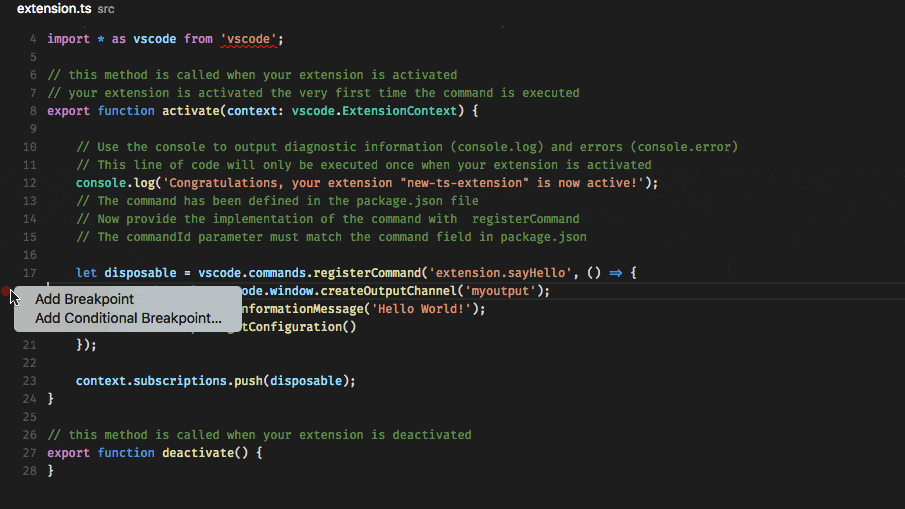
Condition and hit count editing support is also supported for function and exception breakpoints.
You can initiate condition editing from the context menu or the new inline Edit Condition action.
An example of condition editing in the BREAKPOINTS view:
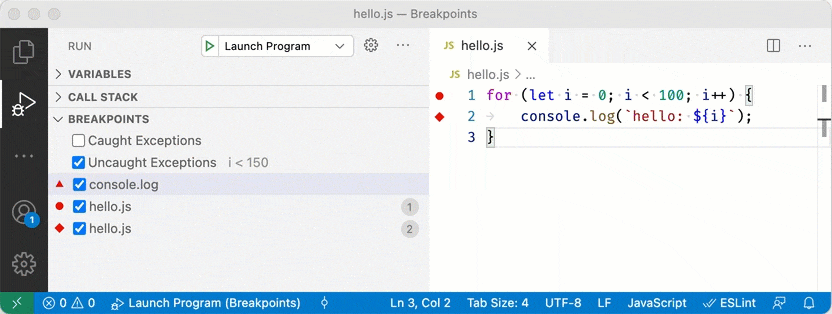
If a debugger does not support conditional breakpoints, the Add Conditional Breakpoint and Edit Condition actions will be missing.
Inline breakpoints
Inline breakpoints will only be hit when the execution reaches the column associated with the inline breakpoint. This is particularly useful when debugging minified code which contains multiple statements in a single line.
An inline breakpoint can be set using ⇧F9 (Windows, Linux Shift+F9) or through the context menu during a debug session. Inline breakpoints are shown inline in the editor.
Inline breakpoints can also have conditions. Editing multiple breakpoints on a line is possible through the context menu in the editor’s left margin.
Function breakpoints
Instead of placing breakpoints directly in source code, a debugger can support creating breakpoints by specifying a function name. This is useful in situations where source is not available but a function name is known.
A function breakpoint is created by pressing the + button in the BREAKPOINTS section header and entering the function name. Function breakpoints are shown with a red triangle in the BREAKPOINTS section.
Data breakpoints
If a debugger supports data breakpoints, they can be set from the VARIABLES view and will get hit when the value of the underlying variable changes. Data breakpoints are shown with a red hexagon in the BREAKPOINTS section.
UseStatusCodePagesWithReExecute
The UseStatusCodePagesWithReExecute extension method:
- Returns the original status code to the client.
- Generates the response body by re-executing the request pipeline using an alternate path.
If you point to an endpoint within the app, create an MVC view or Razor page for the endpoint. Ensure is placed before so the request can be rerouted to the status page. For a Razor Pages example, see Pages/StatusCode.cshtml in the sample app.
This method is commonly used when the app should:
- Process the request without redirecting to a different endpoint. For web apps, the client’s browser address bar reflects the originally requested endpoint.
- Preserve and return the original status code with the response.
The URL and query string templates may include a placeholder () for the status code. The URL template must start with a slash (). When using a placeholder in the path, confirm that the endpoint (page or controller) can process the path segment. For example, a Razor Page for errors should accept the optional path segment value with the directive:
The endpoint that processes the error can get the original URL that generated the error, as shown in the following example:
Don’t mark the error handler action method with HTTP method attributes, such as . Explicit verbs prevent some requests from reaching the method. Allow anonymous access to the method if unauthenticated users should see the error view.
Platform-specific properties
supports defining values (for example, arguments to be passed to the program) that depend on the operating system where the debugger is running. To do so, put a platform-specific literal into the file and specify the corresponding properties inside that literal.
Below is an example that passes to the program differently on Windows:
Valid operating properties are for Windows, for Linux, and for macOS. Properties defined in an operating system specific scope override properties defined in the global scope.
Please note that the property cannot be placed inside a platform-specific section, because indirectly determines the platform in remote debugging scenarios, and that would result in a cyclic dependency.
In the example below, debugging the program always stops on entry except on macOS:
A Simple Error Handling Strategy
With all the different options you may be confused about how to use error handling in VBA. In this section, I’m going to show you how to implement a simple error handling strategy that you can use in all your applications.
The Basic Implementation
This is a simple overview of our strategy
- Place the On Error GoTo Label line at the start of our topmost sub.
- Place the error handling Label at the end of our topmost sub.
- If an expected error occurs then handle it and continue.
- If the application cannot continue then use Err.Raise to jump to the error handling label.
- If an unexpected error occurs the code will automatically jump to the error handling label.
The following image shows an overview of how this looks
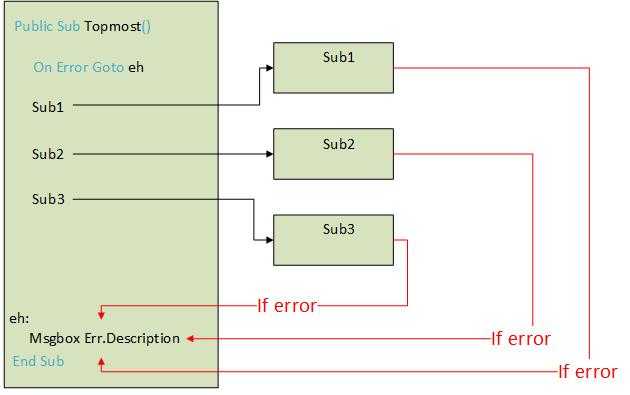
The following code shows a simple implementation of this strategy:
' https://excelmacromastery.com/
Public Const ERROR_NO_ACCOUNTS As Long = vbObjectError + 514
Sub BuildReport()
On Error Goto eh
' If error in ReadAccounts then jump to error
ReadAccounts
' Do something with the code
Done:
Exit Sub
eh:
' All errors will jump to here
MsgBox Err.Source & ": The following error occured " & Err.Description
End Sub
Sub ReadAccounts()
' EXPECTED ERROR - Can be handled by the code
' Application can handle A1 being zero
If Sheet1.Range("A1") = 0 Then
Sheet1.Range("A1") = 1
End If
' EXPECTED ERROR - cannot be handled by the code
' Application cannot continue if no accounts workbook
If Dir("C:\Docs\Account.xlsx") = "" Then
Err.Raise ERROR_NO_ACCOUNTS, "UsingErr" _
, "There are no accounts present for this month."
End If
' UNEXPECTED ERROR - cannot be handled by the code
' If cell B3 contains text we will get a type mismatch error
Dim total As Long
total = Sheet1.Range("B3")
' continue on and read accounts
End Sub
This is a nice way of implementing error handling because
- We don’t need to add error handling code to every sub.
- If an error occurs then VBA exits the application gracefully.
Logpoints
A Logpoint is a variant of a breakpoint that does not «break» into the debugger but instead logs a message to the console. Logpoints are especially useful for injecting logging while debugging production servers that cannot be paused or stopped.
A Logpoint is represented by a «diamond» shaped icon. Log messages are plain text but can include expressions to be evaluated within curly braces (‘{}’).
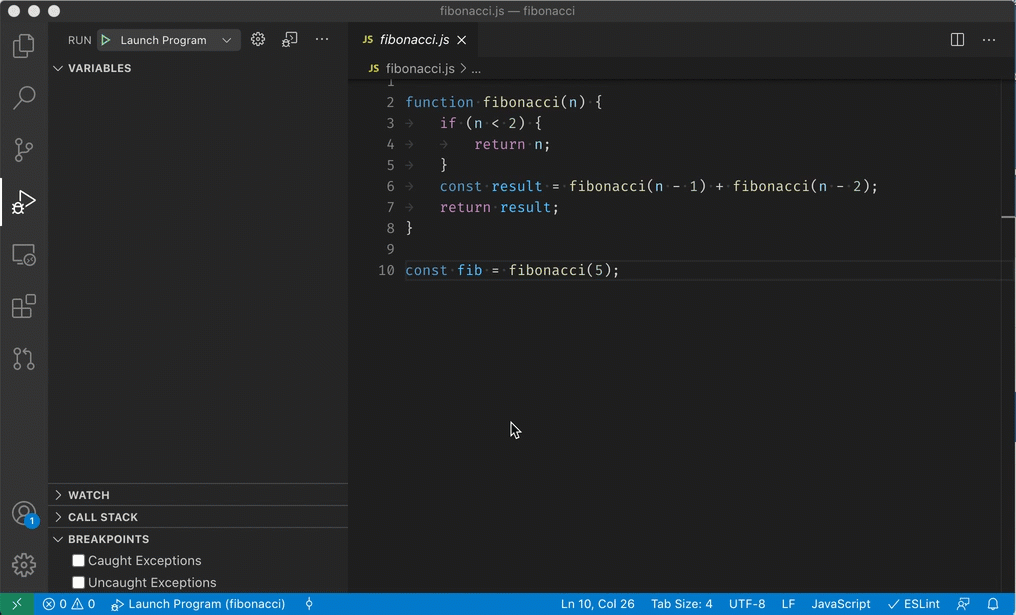
Just like regular breakpoints, Logpoints can be enabled or disabled and can also be controlled by a condition and/or hit count.
Note: Logpoints are supported by VS Code’s built-in Node.js debugger, but can be implemented by other debug extensions. The Python and Java extensions, for example, support Logpoints.
Инструкция block
Инструкция block является фундаментальной и используется для группировки других инструкций. Блок ограничивается фигурными скобками:
{ statement_1; statement_2; ... statement_n; }
Блок обычно используется с управляющими инструкциями (например, , , ).
В вышеприведённом примере является блоком.
Обратите внимание: в JavaScript отсутствует область видимости блока до ECMAScript2015. Переменные, объявленные внутри блока, имеют область видимости функции (или скрипта), в которой находится данный блок, вследствие чего они сохранят свои значения при выходе за пределы блока
Другими словами, блок не создаёт новую область видимости. «Автономные» (standalone) блоки в JavaScript могут продуцировать полностью отличающийся результат, от результата в языках C или Java. Например:
В вышеприведённом примере инструкция внутри блока находится в той же области видимости, что и инструкция перед блоком. В C или Java эквивалентный код выведет значение 1.
Начиная с ECMAScript 6, оператор позволяет объявить переменную в области видимости блока. Чтобы получить более подробную информацию, прочитайте .
Server exception handling
In addition to the exception handling logic in your app, the HTTP server implementation can handle some exceptions. If the server catches an exception before response headers are sent, the server sends a 500 — Internal Server Error response without a response body. If the server catches an exception after response headers are sent, the server closes the connection. Requests that aren’t handled by your app are handled by the server. Any exception that occurs when the server is handling the request is handled by the server’s exception handling. The app’s custom error pages, exception handling middleware, and filters don’t affect this behavior.
Developer exception page
The Developer Exception Page displays detailed information about unhandled request exceptions. ASP.NET Core apps enable the developer exception page by default when running in the Development environment.
The developer exception page runs early in the middleware pipeline, so that it can catch unhandled exceptions thrown in middleware that follows.
Detailed exception information shouldn’t be displayed publicly when the app runs in the Production environment. For more information on configuring environments, see Use multiple environments in ASP.NET Core.
The Developer Exception Page can include the following information about the exception and the request:
- Stack trace
- Query string parameters, if any
- Cookies, if any
- Headers
The Developer Exception Page isn’t guaranteed to provide any information. Use Logging for complete error information.
Ошибка на уровне ячейки
Ошибка на уровне ячейки не помешает загрузить запрос, но отображает ошибочные значения в ячейке. При выборе пустого пространства в ячейке отображается область ошибок под предварительной версией данных.
Примечание
Средства профилирования данных позволяют легко определить ошибки на уровне ячеек с помощью функции «качество столбца». Дополнительные сведения:
Обработка ошибок на уровне ячейки
При возникновении ошибок на уровне ячеек Power Query предоставляет набор функций для их обработки путем удаления, замены или сохранения ошибок.
В следующих разделах приведенные примеры будут использовать тот же образец запроса, что и начальная точка. В этом запросе имеется столбец Sales , содержащий одну ячейку с ошибкой, вызванной ошибкой преобразования. Значение в этой ячейке равно » НД», но при преобразовании этого столбца в целое число Power Query не удалось преобразовать НД в число, поэтому отобразится следующая ошибка.
Удалить ошибки
Чтобы удалить строки с ошибками в Power Query, сначала выберите столбец, содержащий ошибки. На вкладке Главная в группе уменьшить строки выберите Удалить строки. В раскрывающемся меню выберите пункт удалить ошибки.
В результате этой операции вы получите таблицу, которую вы ищете.
Заменить ошибки
Если вместо удаления строк с ошибками необходимо заменить их фиксированным значением, это также можно сделать. Чтобы заменить строки с ошибками, сначала выберите столбец, содержащий ошибки. На вкладке Преобразование в группе все столбцы выберите заменить значения. В раскрывающемся меню выберите команду заменить ошибки.
В диалоговом окне Замена ошибок введите значение 10 , так как необходимо заменить все ошибки значением 10.
В результате этой операции вы получите таблицу, которую вы ищете.
Не учитывать ошибки
Power Query может служить хорошим средством аудита для обнаружения любых строк с ошибками, даже если эти ошибки не устранены. Именно здесь могут быть полезны ошибки сохранения . Чтобы избежать возникновения ошибок в строках, сначала выберите столбец, содержащий ошибки. На вкладке Главная в группе сокращение строк выберите параметр не учитывать строки. В раскрывающемся меню выберите пункт не учитывать ошибки.
В результате этой операции вы получите таблицу, которую вы ищете.
Распространенные ошибки на уровне ячеек
Как и в случае с любой ошибкой на уровне шага, мы рекомендуем ознакомиться со статьей причины ошибок, сообщения об ошибках и сведения об ошибках, предоставленные на уровне ячейки, чтобы понять, что вызывает ошибки. В следующих разделах рассматриваются некоторые из наиболее часто встречающихся ошибок на уровне ячеек в Power Query.
Ошибки преобразования типов данных
Часто запускается при изменении типа данных столбца в таблице. Некоторые значения, найденные в столбце, не могут быть преобразованы в нужный тип данных.
Пример. у вас есть запрос, который содержит столбец с именем Sales. Одна ячейка в этом столбце содержит значение « НД » в качестве значения ячейки, а в остальных — целые числа. Вы решили преобразовать тип данных столбца из текстового в целое число, но ячейка со значением НД вызывает ошибку.
Возможные решения. После определения строки с ошибкой можно изменить источник данных, чтобы он отражал правильное значение, а не НД, или применить операцию замены ошибки , чтобы предоставить значения для любых значений НД , вызвавших ошибку.
Ошибки операций
При попытке применить неподдерживаемую операцию, например умножить текстовое значение на числовое значение, возникает ошибка.
Пример. необходимо создать настраиваемый столбец для запроса, создав текстовую строку, содержащую фразу «общий объем продаж:», Объединенную со значением из столбца » продажи «. Ошибка возникает из-за того, что операция объединения поддерживает только текстовые столбцы, а не числовые.
Возможные решения. перед созданием этого пользовательского столбца измените тип данных столбца Sales на Text.
UseStatusCodePagesWithReExecute
The UseStatusCodePagesWithReExecute extension method:
- Returns the original status code to the client.
- Generates the response body by re-executing the request pipeline using an alternate path.
If you point to an endpoint within the app, create an MVC view or Razor page for the endpoint. Ensure is placed before so the request can be rerouted to the status page. For a Razor Pages example, see Pages/StatusCode.cshtml in the sample app.
This method is commonly used when the app should:
- Process the request without redirecting to a different endpoint. For web apps, the client’s browser address bar reflects the originally requested endpoint.
- Preserve and return the original status code with the response.
The URL and query string templates may include a placeholder () for the status code. The URL template must start with a slash (). When using a placeholder in the path, confirm that the endpoint (page or controller) can process the path segment. For example, a Razor Page for errors should accept the optional path segment value with the directive:
The endpoint that processes the error can get the original URL that generated the error, as shown in the following example:
Don’t mark the error handler action method with HTTP method attributes, such as . Explicit verbs prevent some requests from reaching the method. Allow anonymous access to the method if unauthenticated users should see the error view.
Exception filters
In MVC apps, exception filters can be configured globally or on a per-controller or per-action basis. In Razor Pages apps, they can be configured globally or per page model. These filters handle any unhandled exception that occurs during the execution of a controller action or another filter. For more information, see .
Tip
Exception filters are useful for trapping exceptions that occur within MVC actions, but they’re not as flexible as the Exception Handling Middleware. We recommend using the middleware. Use filters only where you need to perform error handling differently based on which MVC action is chosen.
Parsing response body data
To carry out assertions on your responses, you will first need to parse the data into a JavaScript object that your assertions can use.
To parse JSON data, use the following syntax:
To parse XML, use the following:
To parse CSV, use the CSV parse utility:
To parse HTML, use cheerio:
Handling responses that don’t parse
If you can’t parse the response body to JavaScript because it’s not formatted as JSON, XML, HTML, CSV, or any other parsable data format, you can still make assertions on the data.
Test if the response body contains a string:
This doesn’t tell you where the string was encountered because it carries out the test on the whole response body. Test if a response matches a string (which will typically only be effective with short responses):
Trapping exceptions
This section describes how to trap predefined TimesTen errors or user-defined errors.
Trapping predefined TimesTen errors
Trap a predefined TimesTen error by referencing its predefined name in your exception-handling routine. PL/SQL declares predefined exceptions in the package.
lists predefined exceptions supported by TimesTen, the associated error numbers and values, and descriptions of the exceptions.
Also see .
Example 4-1 Using the ZERO_DIVIDE predefined exception
In this example, a PL/SQL program attempts to divide by 0. The predefined exception is used to trap the error in an exception-handling routine.
Command> DECLARE v_invalid PLS_INTEGER;
> BEGIN
> v_invalid := 100/0;
> EXCEPTION
> WHEN ZERO_DIVIDE THEN
> DBMS_OUTPUT.PUT_LINE ('Attempt to divide by 0');
> END;
> /
Attempt to divide by 0
PL/SQL procedure successfully completed.
Как выводить данные полученные из файла с помощью file_get_content
Для вывода данных на странице можно использовать echo.
Для того, чтобы выводить данные полученные с другой страницы с помощью file_get_content, вам нужно:
Определить, что вам нужно от этой страницы,
либо код .
Если вам нужен первый вариант, то сооружаем такую конструкцию :
echo file_get_content(‘https://dwweb.ru/путь/название_файла’);
путь на сервере до корневой папкиecho file_get_content( $_SERVER .’/путь/название_файла’);
И внимание!
Если вы собираетесь выводить данные выше перечисленными способами и если там есть код html, то при выводе он сработает!
htmlspecialchars





![Что такое ошибка http 302 и как ее исправить? [4 протестированных метода объяснено]](http://fuzeservers.ru/wp-content/uploads/a/e/0/ae0eb6246d83c08caf527e16ce90a9bd.jpeg)


















![Что такое ошибка http 302 и как ее исправить? [4 протестированных метода объяснено]](http://fuzeservers.ru/wp-content/uploads/5/9/6/596caac477dd90728deba7540a0a66e7.jpeg)



